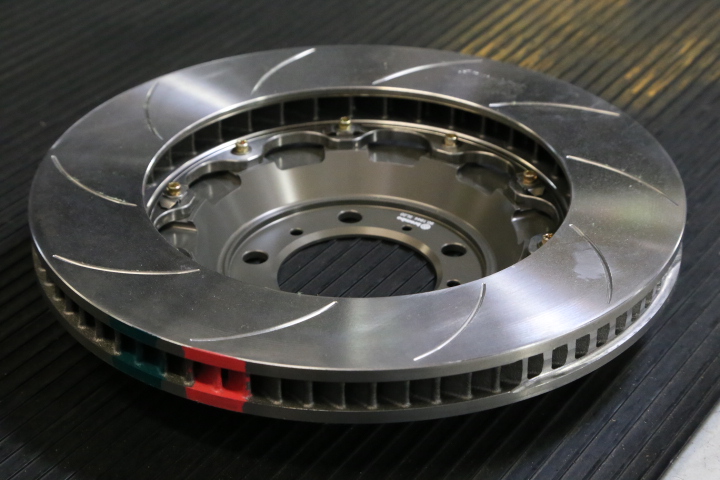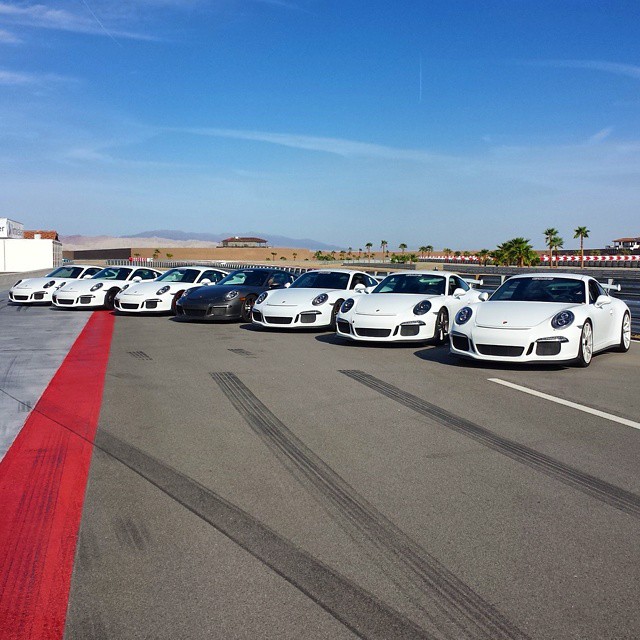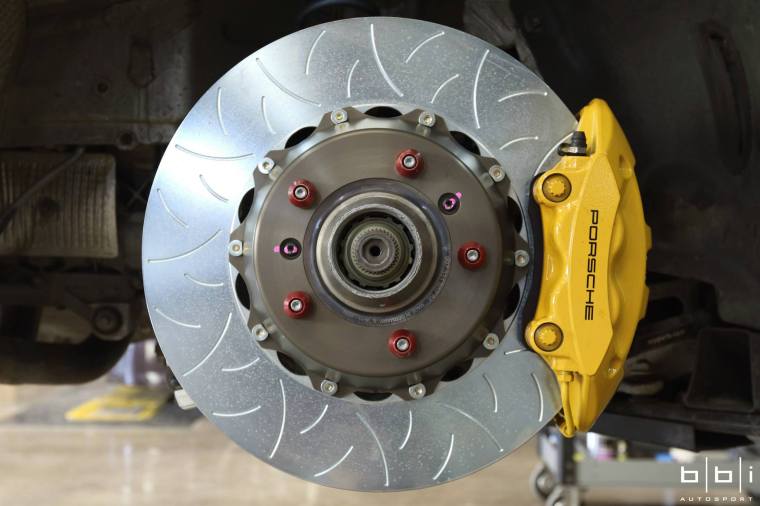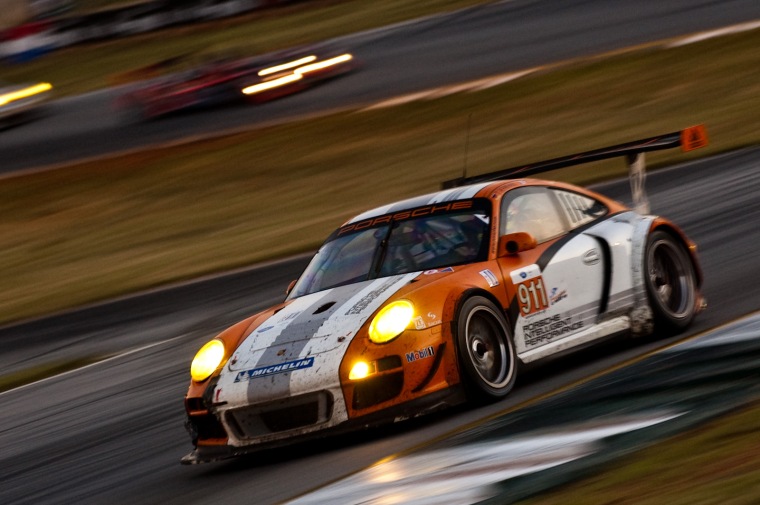BREMBO GT|TY3 2-PIECE DISC UPGRADE FOR THE PORSCHE CAYMAN GT4 (981):
OFF THE SHOWROOM FLOOR AND STRAIGHT TO THE TRACK: The brand new Cayman GT4 (981) is Porsche’s lightweight platform specifically focused for the racetrack and track day enthusiasts.
THE PORSCHE 911 (991) DNA: Since most of the front end, upright, and suspension components on the Porsche Cayman GT4 are from the Porsche 991 GT3 (911), the Brembo OE (Original Equipment) brakes equipped on the Porsche Cayman GT4 are some of the most sophisticated designed for an OE application.
CAYMAN GT4 VS. 911 GT3: The Porsche Cayman GT4 Brembo OE brakes utilize 6-piston aluminum fixed monobloc calipers front and 4-piston aluminum fixed monobloc calipers in the rear. The Cayman GT4 uses heavy duty 380 x 34 mm ventilated front & 380 x 30 mm rear brake discs similar to what is equipped on a Porsche 991 GT3. The Porsche Cayman GT4 brakes also uses a wide annulus (radial depth) front and rear pad for maximum swept area, heat dissipation, and pad life. The OE pads are also 18 mm thick front and rear which is comparable to most high performance aftermarket calipers.
HOW THEY DIFFER FROM EACH OTHER: While the Porsche Cayman GT4 and 991 GT3 are similar on paper in many ways, there are some of major technical differences between the Porsche 991 GT3 and Cayman 981 GT4.
These technical differences significantly affect overall brake balance setup and performance.
- The Porsche Cayman’s suspension setup (especially the rear), geometry, and dynamic weight distribution is fundamentally different resulting in an overall chassis balance that is more sensitive to braking inputs than a GT3.

The Cayman GT4 is more sensitive to driver inputs, especially pitch under braking. Photo: GMG Racing
The Cayman’s inherent tendency to pitch more under braking increases front axle brake demand, but inherently results in unsettling the rear axle under braking. However, this can be tuned with managing the operating temperature of the brake disc and also by using different friction compounds that are optimized for the specific brake temperature windows.
BREMBO DISC OPTIONS: The front Brembo 380 x 34 / 72 Vane racing disc used for the GT4 application are available in multiple configurations (standard or heavy duty and TY3 Sprint or TY5 Endurance) to help the user setup the brakes to suit their demands.
- The Porsche’s Cayman GT4 is a true mid-engine platform with the engine sitting in front of the rear axle closer to the center of the chassis unlike the 991 GT3 which is a rear-engine platform with the engine sitting over the rear axle.

The Porsche Cayman GT4 is a mid-engine platform with the engine closer to the center of the chassis. Photo: GMG Racing
MID-ENGINE VS. REAR-ENGINE: A mid-engine platform will generally demand less out of the rear brakes compared to a rear-engine platform with all the weight sitting on the rear axle. The Cayman’s mid-engine design also inherently results in the rear axle getting unsettled easier under braking inputs.
STABLE DISC TEMPERATURES: The rear Brembo 380 x 30 TY3 racing disc, used for the GT4 application is offered in a 48 vane configuration. This 48 vane disc configuration stores more heat in the disc, which allows for more stable rear brake temperatures, resulting in improved disc life for the intended use.
- The Porsche Cayman GT4 generally weighs 200 lbs less than a 991 GT3 (Cayman GT4 Curb Weight – 2955 lbs, 991 GT3 Curb Weight – 3150 lbs).
Overall weight and weight balance directly influence a vehicle’s brake demand. The Cayman GT4 with less overall weight (especially over the rear axle) will also demand significantly less out of the rear brakes compared to a 991 GT3.
- The Porsche Cayman GT4’s bumper design and aerodynamics are different and more adjustable than a 991 GT3. The Cayman GT4 features an adjustable front diffuser and rear wing to increase downforce and grip versus the non-adjustable parts on the 991 GT3.
Bumper design has a significant influence on airflow to the brake system which results in different braking demands on the front and rear axles. Increased downforce and grip also affects brake balance and demand depending on the exact chassis setup.

Porsche Cayman GT4 front bumper with adjustable flaps integrated in the bumper to increase brake cooling and downforce. Photo: GMG Racing
IN CONCLUSION: There are certain limitations with the OE components on any high performance application as they are designed specifically for the car manufacturers to their requirements of comfort, wear rates in various road environments, cost and serviceability.
As the braking system’s primary function is to dissipate heat, Brembo uses purpose-designed discs in order to increase the fade resistance and thermal capacity of the system. These discs are directionally ventilated for enhanced cooling and slotted for better performance and continuously refreshing the pad surface. Brembo Performance 2-piece discs are made up of a proprietary advanced cast-iron alloy which offers an exceptional coefficient of friction and resistance to thermal shock and fatigue.
The same Brembo Racing discs trusted every weekend in professional motorsports are also utilized in the Brembo Performance Program (GT, GT-R & Race Systems).
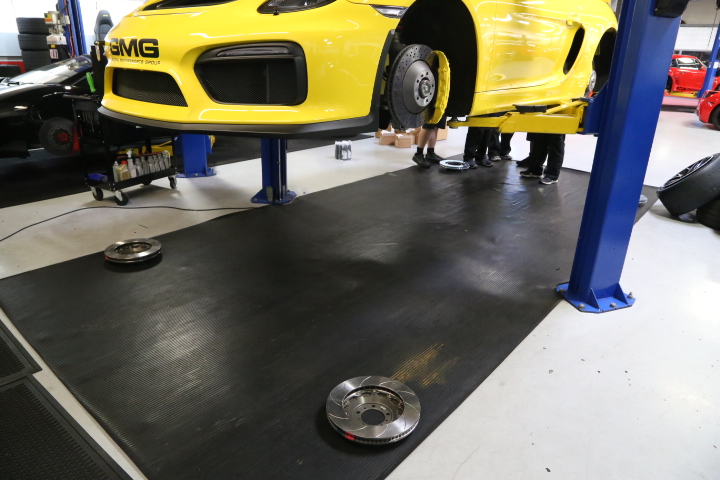
GMG’s Cayman GT4 Brembo OE brakes being swapped out for Brembo Performance 2-piece disc and Race Technologies pad upgrades
BENEFITS OF BREMBO 2-PIECE DISC UPGRADES:
- OEM INTEGRATION: Brembo 2-piece disc upgrades are designed to work seamlessly with the OE calipers and systems (manufactured by Brembo for Porsche). This guarantees the utmost in safety and seamless fitment.
- LIGHTWEIGHT: Disc assemblies include an outer iron disc with aluminum bell/hat and provide decreased corner weights to improve vehicle dynamics including handling, acceleration, and braking.
- TYPE III SLOT PATTERN: Extensively used in professional motorsports, the Type III slot pattern offers a high initial response with excellent release characteristics.
- HIGH THERMAL CAPACITY: Greatly improved thermal capacity and heat management over OE discs and other aftermarket discs in the market. This also improves braking performance and allows for greater longevity of the components.
- FRICTION MATERIALS: Everything we learn by supporting top professional racing teams throughout the world goes into selecting the best brake pad options for all levels of street, track and racing use.
PACKAGES INCLUDE:
- Outer Brembo TY3 discs (qty 2)
- 6061 T6 aluminum (machined from billet), hard anodized bell/hat
- Complete Brembo disc hardware (D-type bobbin) w/ anti-rattle springs. (Full Floating Option Available Upon Request).
BREMBO CAYMAN GT4 (981) 2-PIECE DISC OPTIONS:
FRONT BREMBO 2-PIECE DISC OPTIONS: 981 CAYMAN GT4 OE IRON EQUIPPED
MSRP COMPLETE AXLE SET: $1,895.00
981 Cayman GT4 Front disc specifications:
– 380 x 34 disc – Standard
– TY3 slot type
– 20 mm air-gap (wide air-gap for overall brake disc weight reduction)
– 72 vane ventilation
– 21 lbs – disc ring
– 23 lbs – complete 2-piece disc assembly
981 Cayman GT4 Front “High Thermal” disc specifications:
– 380 x 34 disc – High Thermal
– TY3 or TY5 “Endurance” slot type available.
– 17 mm air-gap (narrow air-gap for the brake disc to have extra thermal capacity and durability under higher brake demand conditions)
– 72 vane ventilation
– 23 lbs – disc ring
– 24.5 lbs – complete 2-piece disc assembly
– Compatible with 911 Turbo (991) Models
REAR BREMBO 2-PIECE DISC OPTIONS: 981 CAYMAN GT4 OE IRON EQUIPPED
MSRP COMPLETE AXLE SET: $1,895.00
981 Cayman GT4 Rear “High Thermal” disc specifications:
– 380 x 30 disc – High Thermal
– TY3 slot type
– 16 mm air-gap
– 48 vane ventilation
– 20 lbs – disc ring.
– 22 lbs – complete 2-piece disc assembly
– Compatible with factory braking brake (e-brake)
PORSCHE CAYMAN GT4 (981) OEM DISC WEIGHTS – FOR REFERENCE:
– Front, 380 x 34: Approximately 24 lbs
– Rear, 380 x 30: Approximately 22.5 lbs
















